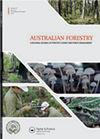提高瓦努阿图白木的硬度
IF 1.2
4区 农林科学
Q3 FORESTRY
引用次数: 0
摘要
瓦努阿图几乎耗尽了其原生森林木材供应,寻求通过建立森林种植园来重建。白木(Endopsermum medulosum)已被确定为一种适合作为人工林的本土硬木:它具有良好的生长,抗大风和生产细纹理的白色木材。然而,白木的木材密度低,机械性能相对较差。特别是,软木材在需要良好硬度的地方表现不佳,例如地板。试验了几种木材改性技术,主要目的是提高白木的硬度。所测试的方法被选为对环境影响小的简单处理方法,因此可以在瓦努阿图安全实施。在所测试的处理中,甲基丙烯酸甲酯聚合物浸渍提供了最大的硬度增加。与地板使用相称的数值(约6000 N)是未经处理对照的三倍。通过使用甲基丙烯酸甲酯填充处理,可以提高白木的硬度,扩大利用机会,包括国内和国际地板木材市场。这反过来又将改善白木生产的投资保障和农村小土地所有者的生活水平。本文章由计算机程序翻译,如有差异,请以英文原文为准。
Improving the hardness of Endospermum medullosum (Vanuatu whitewood)
ABSTRACT Having almost exhausted its native forest wood supply, Vanuatu has sought to rebuild by establishing forest plantations. Whitewood (Endopsermum medulosum) has been identified as a native hardwood suitable as a plantation species: it has good growth, is resistant to high winds and produces finegrained white timber. However, whitewood has low wood density and comparatively poor mechanical properties. In particular, the soft timber does not perform well where good hardness is required, such as in flooring. Several wood modification techniques were tested with the primary aim of improving whitewood hardness. The methods tested were selected as simple treatments with low environmental impact and which, consequently, may be implemented safely in Vanuatu. Of the treatments tested, impregnation with methyl methacrylate polymer provided the greatest increase in hardness. Values commensurate with use as flooring were obtained (about 6000 N) that were three times greater than untreated controls. With treatment using methyl methacrylate bulking, the hardness of whitewood can be improved, expanding utilisation opportunities to include markets for flooring timbers, domestically and internationally. This, in turn, will improve investment security in whitewood production and the living standards of small rural landholders.
求助全文
通过发布文献求助,成功后即可免费获取论文全文。
去求助
来源期刊

Australian Forestry
FORESTRY-
CiteScore
3.70
自引率
4.80%
发文量
15
审稿时长
>12 weeks
期刊介绍:
Australian Forestry is published by Taylor & Francis for the Institute of Foresters of Australia (IFA) for scientific, technical, and professional communication relating to forestry in the Asia Pacific.
 求助内容:
求助内容: 应助结果提醒方式:
应助结果提醒方式:


